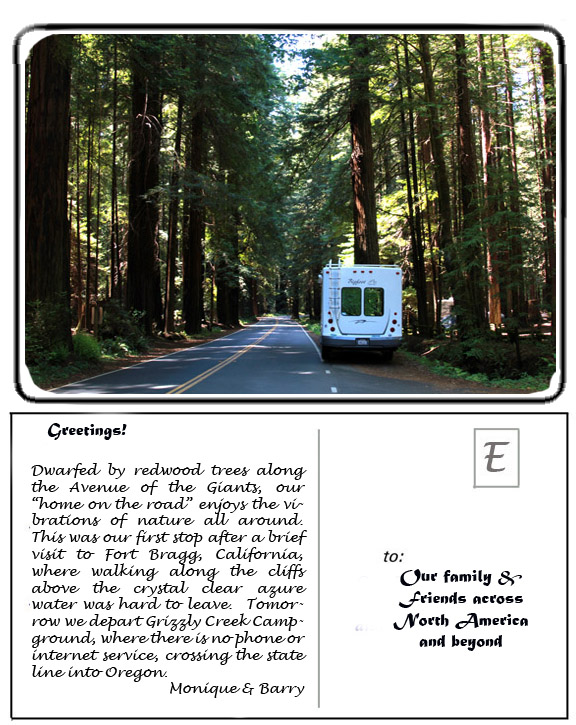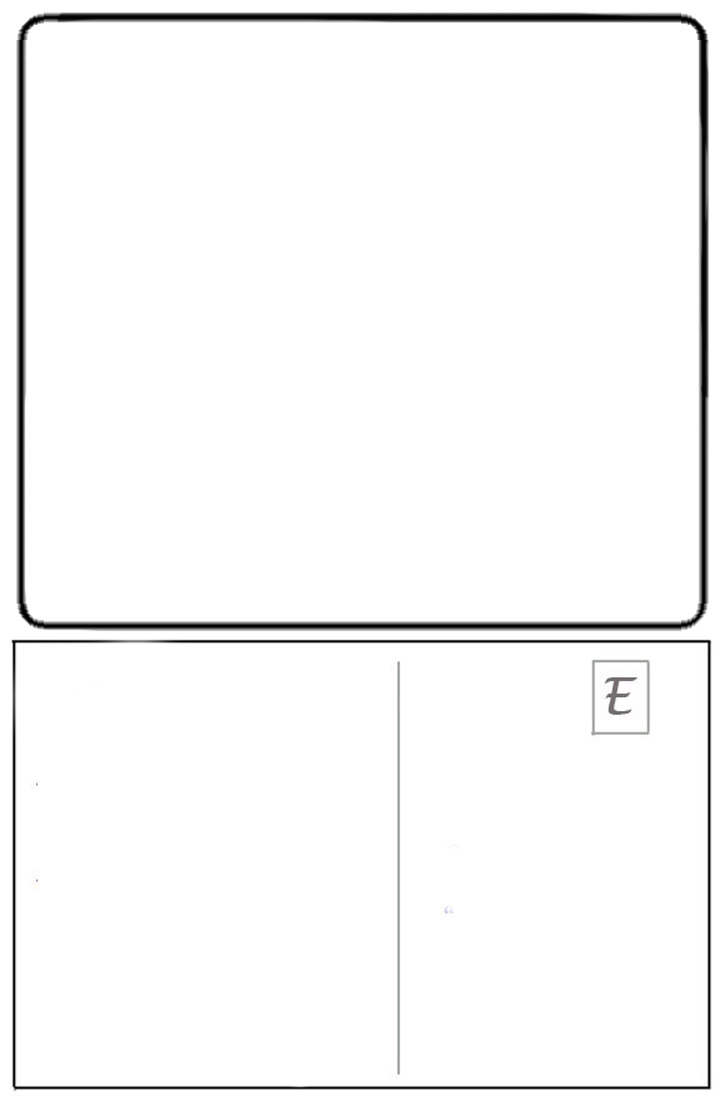You’ve fled the comfort of your home, off to exotic places. Many of your friends think you’re following in the footsteps of Davy Crockett or Lewis & Clark, having driven away in your RV from the paved streets of the suburbs or city to challenge the wilderness. Of course you know better. You’re visiting new or favorite places, enjoying comfortable surroundings, and at night returning to your coach with your own pillows and personal items close at hand.
Communicating with folks back home or around the world about your adventures has certainly gotten easier over the years, thanks to social media and the internet; but, for many people, Facebook posts and the like have become more impersonal. More and more postings have a dozen of mediocre photos that you feel somewhat forced to review.
Several years ago, my wife Monique devised “e-Postcards” with one photo and a brief paragraph about where we are and what we have seen. From our many experiences on the road, we select and email the most interesting, focusing on just one subject. The responses over the years have been gratifying.
What is an e-Postcard? Since a picture is worth a thousand words, here’s an example:

For our e-Postcards, we like to put emphasis on places rather than people, unless there’s something novel or educational about the people, such as an Indian tribal dance or crew member on a fishing boat.
We don’t use a “selfie stick” to insert ourselves into every photo; as a matter of fact, we rarely have ourselves in the picture. The basic e-Postcard can be a paragraph of 40-100 words or less about what you experienced, with a photo as an attachment. Since there are so many email programs, trying to explain more sophisticated methods isn’t practical.
One important suggestion: in the “To” section of your email, put the addresses of recipients under “bcc,” which means “blind copy.” The email will go out without names of all the addressees viewable.
One additional point: to make each e-Postcard special, I space them a few days to a week apart when on the road. You can save other photos for the premier showing when you return home.

How to Create an E-Postcard
The question arises, “How do you set up the e-Postcards you want to send out?” The answer is, “It’s not easy!” but I’ll give some suggestions, and once you try it, it will get easier.
First, if you’re adept at Photoshop or similar graphics programs, it’s just a matter of drawing lines to create the postcard, saving it as the e-Postcard format, copying the format into a folder for each e-Postcard and then dropping in a picture and text. I get fancy with feathering (rounding edges), but that’s not necessary – what your readers appreciate is a picture and brief explanation of where you are.
Supposing you’re still perfecting your graphics skills – mastering the power of Photoshop, CorelDraw, or other graphics programs isn’t on your bucket list. How do you put together an e-Postcard?
Honestly, for the first six months after initiating the idea, I did it a simple way, one that was still appreciated by recipients. I opened a blank new document in Microsoft Word, clicked on “insert photo from file,” and brought in the picture I wanted to send out. Under that I typed in the text describing our travels and the photo, again, keeping it down to three or four sentences max.
That would be the attachment. In the body of the email, I would say something like, “Here’s my e-Postcard to you.”
If you are among those who use Gmail, look at the bottom of the screen, where you will see a little black square with white mountains on it, which invites you to upload a picture directly into the screen. That will put the e-Postcard into the body of the email rather than as an attachment. If your email service doesn’t offer that, just add the e-Postcard as an attachment.

This is the basic format that I use, but I invite you to modify it as best suits your needs and abilities.
If you’re ready to get started now, I’ll walk you through it the easiest way I can using a JPEG format:
- Open the e-Postcard format you’ve created and increase the size to 10”.
- Open the photo you want to send, reduce it to 9½”, drag it into the format’s top box. (Hopefully it will be a square; otherwise, you will need to modify the shape of the box, or put in filler, such as a color compatible with the colors in the photo. See example below.)
- In Microsoft Word or the word program you use, type your message, highlight it, and copy. Start it with something like, “To my good friends and relatives”.
- Add a text box to the format on the bottom left and paste the message.
- Add another text box on the bottom right and “address” the e-postcard.
- In the “To” or “Recipients” space of your email, select “bcc” or “blind copy” and add the names of those who are to receive the mailing.
- In the Subject block, put in something like, “e-Postcard from Rio”.
- Send
For your first e-Postcard, I suggest an introduction outside the postcard itself, explaining what you’re doing and inviting recipients to opt out if they don’t wish to receive them.
And now a step-by-step illustration:
I welcome your comments and questions below in the Response section of this post. For a JPEG or Photoshop version of the format, email me directly at neverboredrvers@gmail.com.
From the Never-Bored RVers. See you on down the road.

About the Author: Barry Zander spent a decade as a newspaper reporter and editor, was president of an advertising/PR agency, and was in marketing before retiring in 2006. That was when Monique suggested selling their home and buying an RV to travel North America. After five years full-timing, they bought a cabin in the mountains of Southern California, the base for continuing travels. You can read more of Barry’s adventures on his blog, On Top of the World.


This is great.
This is great. I do not posses most of the knowledge needed to do this, but am starting today to master what is needed. I’m beginning today to accomplish what is needed and use this format to keep my friends and family aware of the conversion (which I’m also just starting) and my subsequent travels. Thank you so much for putting this up. it’s great, I’m so excited about getting started. Thank you, Gene
Just read your post on e-cards, really like your idea but until I can play a bit more with my apple, we have been using FB (I totally dislike FB but it's my wife's choice of communication right now) The last five years we have been traveling from Sebring, FL the Great NW. We are professional house/pet sitters and use "Trusted House Sitters" for our contacts. By the way until this year it's been on a Honda Goldwing GL1800. This year? RVing. Another story some time if you're interested. Frank & Judy Although I rarely post of Facebook, I realize it can be an alternative to the e-Postcard mailings. If your “friends” list is indeed friends who you want to tell about your travels, it would work as well. Just post a photo and brief explanation starting with “Our e-Postcard.” Any personal comments about your experiences can be in a separate posting.
A cute idea from back in the days of real postcards. Say you have 10 people you will send the cards to. Number the cards "1 of 10", "2 of 10", etc. Then write a log story, starting with the first card and continuing across each card to the last. Each card will indicate who the preceding card was sent to and who the following card was sent to. For them to read the whole story, they all have to get together.
Brice Canyon Ut